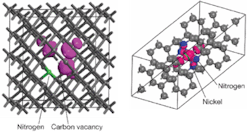QUANTUM DEVICES: Diamond technology enables practical single-photon sources
STEVEN TRPKOVSKI, LLOYD HOLLENBERG, AND STEVEN PRAWER
Emission resulting from the excitation of a single atom or quantum dot is commonly used as a single-photon source, but these sources have presented several challenges that have limited their use largely to the laboratory environment. Using nanodiamond technology, we have overcome these issues and have developed the first packaged, single-photon source that operates at room temperature and in well-lit environments.
An ideal single-photon source produces one and only one photon per pulse. Such sources are key components for building quantum information systems that can implement quantum-key distribution (QKD) for ultrasecure communications. Transmitting only one photon per pulse means the laws of quantum mechanics ensure that any attempt to intercept or read the photon will result in it being irreversibly altered and this interference can be detected by the genuine sender and receiver (see www.laserfocusworld.com/articles/255503).
Until now, single-photon sources worked only at low temperatures and were often not stable for long periods of time. The need for cryogenic cooling often limited the ability to use a high-numerical-aperture lens, thus resulting in comparatively low count rates. Further, a relatively high level of background noise resulted in a high incidence of pulses containing more than one photon per pulse, which compromised the security of the QKD protocol. The expense and complexity of the sources limited their “real-world” applications in QKD systems.
The development of single-photon sources based on nanodiamond technology has gathered momentum recently, primarily because they can operate reliably at room temperature. For applications in QKD, such as the use of diamond as a source of single photons, isolated high-quality diamond crystals of subwavelength size are highly desirable because the emitted photons can be collected with higher efficiency than is possible from large single crystals or continuous films. Two optically active color centers in diamond have been found to be prime candidates for single-photon emission, via the nitrogen-vacancy (N-V) center emitting in the range 600 to 750 nm, and nickel/nickel-nitrogen (Ni-N)-related centers emitting in the range 700 to 850 nm.
Together with the Diamond Group at the University of Melbourne (Parkville, Victoria, Australia) we use modified plasma-enhanced chemical-vapor deposition and ion-implantation techniques to manufacture single-photon sources. Color centers such as N-V or Ni-N are artificially created within the diamond nanocrystal using a set of processing steps refined to produce a high probability of a single color center per crystal. This delivers a very high rate of single photons with low background noise.
We have found the N-V color center is more readily created than the Ni-N color center. The N-V center in diamond, as a single-photon source, has been well studied over the last decade.1, 2 An N-V center consists of a single substitutional nitrogen atom adjacent to a vacancy site in the diamond lattice as ab initio calculations predict (see Fig. 1, left). It exhibits electronic transition at 1.945 eV (637 nm) in the negative charge state.3 The lifetime of this transition is about 14 ns, thus in principle allowing count rates of tens of megahertz. However, for applications in telecommunications, particularly QKD in optical fibers, it does exhibit some disadvantages, such as a wide phonon sideband and broad photon emission centered about 637 nm, which is far below the telecommunications windows.
By comparison, Ni and Ni-N color centers are far more promising for quantum-key distribution in optical fiber or free-space applications. For example, the NE8 center, which has one Ni surrounded by four N atoms, as ab initio calculations show (see Fig. 1, right), exhibits narrow (1 to 3 nm) photon emission centered about 800 nm, making it an ideal candidate as a single-photon source for free-space QKD. The lifetime is on the order of 1 to 3 ns, which theoretically enables ten times the count rate than that available from N-V centers.
Source characterization
To measure the performance of a single-photon source, one has to determine its photon statistics. The photon statistics can be measured by the autocorrelation function g(2)(0) using the well-known Hanbury-Brown and Twiss interferometer. The interferometer consists of a fiber-optic beamsplitter and two silicon avalanche photodiodes operating in single-photon counting mode (see Fig. 2).With this confirmed success, we pursued integration of a single N-V diamond nanocrystal into a packaged product. First we developed a methodology to reliably fabricate single N-V diamond nanocrystals. These nanocrystals had to meet certain single-photon specifications, such as count rates of at least 150 kHz and g(2)(0) values smaller than 0.1. Engineering a stable photonic platform in the nanoscale regime required some precision photonics. The result is the SPS 1.01, the first packaged, stable, high-count-rate, optical-fiber-integrated, robust, single-photon source, which not only operates at room temperature but also in well-lit environments. The SPS 1.01 demonstrates stable single-photon performance over weeks of continuous operation without the requirement of recalibration, a truly remarkable feat considering that photons are being collected from a single atomic defect.
ACKNOWLEDGMENTS
The development of the single-photon source through Quantum Communications Victoria was supported by the Victorian Government STI program.
REFERENCES
- C. Kurtsiefer et al., Phys. Rev. Lett. 85, 290 (2000).
- A. Beveratos et al., European Phys. J. D 18, 191 (2002).
- F. Jelezko et al., Phys. Stat. Sol. 203, 3207 (2006).
- V. A. Nadolinny et al., J. Phys.: Condens. Matter 11, 7357 (1999).
- J. R. Rabeau et al., Appl. Phys. Lett. 86, 131926 (2005).
STEVEN TRPKOVSKI is a product development director, LLOYD HOLLENBERG is theoretical technical director, and STEVEN PRAWER is experimental technical director at Quantum Communications Victoria, School of Physics, The University of Melbourne, Parkville, Victoria, Australia 3010; e-mail: [email protected]; www.qcvictoria.com.


